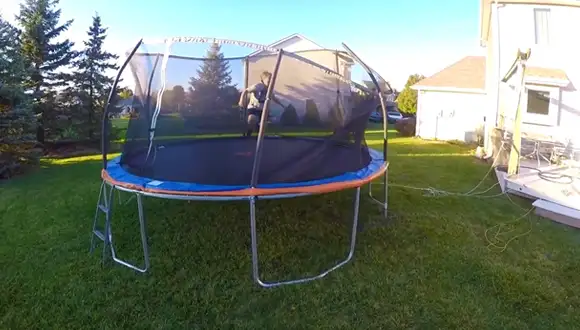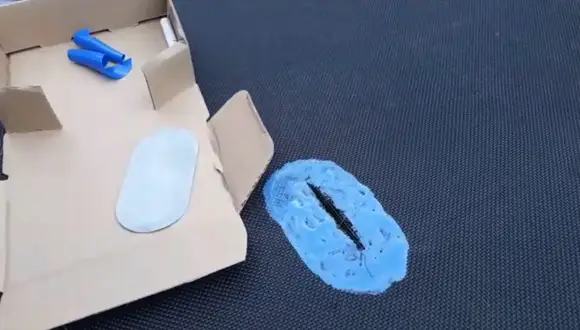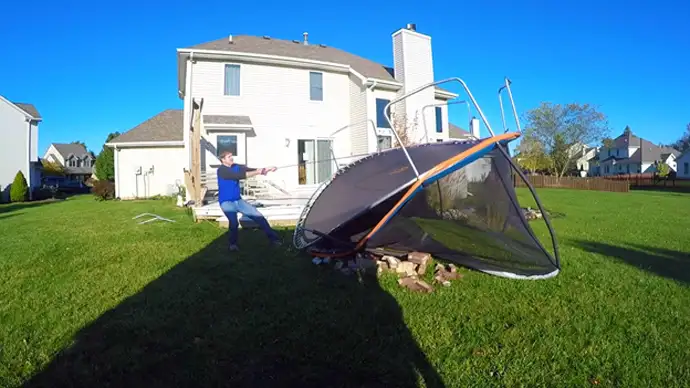Doctors tend to discourage their use and generally do not recommend them due to safety concerns, even though trampolines are in high demand and they are a huge hit. Using data from the National Electronic Injury Surveillance System, more than a hundred thousand trampoline injuries occur each year in the United States, and approximately 84% plus of these injuries occur in children.
Warped trampolines are often the cause of injury because they cause the user to land off-center, on the hard metal frame, or on the spring. When your trampoline is warped and turns unusable, you probably spend a lot of money on it, and now it just sits in the backyard collecting leaves and dirt. And now you can’t even enjoy it.
How to Fix a Warped Trampoline is a solution guide where we will show you how to identify the cause of the warp, fix it, and prevent it from happening again. You’ll be able to use your trampoline again and can get back to bouncing and have a good time. Follow these simple steps to fix your warped trampoline.
How to Fix a Warped Trampoline: Reason, Repair, and Prevention

There are several possible reasons for a warped trampoline, and most of them are fixable. One of the most common problems with trampolines is that they can become warped.
When this happens, the trampoline can become unstable and may even collapse instead of bouncing back. That is why it is important to identify the reason for the warped trampoline before you use it.
By identifying the proper reason for the warped trampoline and taking steps to prevent a trampoline from getting into these problems, you can help ensure that your trampoline remains safe and functional; and enjoy your trampoline.
Determine the Reason for the Warped Trampoline
Check if the trampoline legs are secured:
Check the legs to see if they are properly secured to the frame. One of the most important safety features of a trampoline is that the legs are securely fastened to the frame. If the trampoline legs are not properly attached, they will not provide a secure base for the trampoline.
Unless the legs of the trampoline are completely level, the trampoline will rock back and forth, making it difficult to jump. The trampoline could tip over, which could cause serious injury to anyone using it.
Examine whether the legs are the same length or not. If they are not, the trampoline will be tilted and uneven, making it difficult to bounce and increasing the risk of injury.
Check whether all trampoline legs are extended or not:
Check whether all of the trampoline legs are extended fully and are not locked into place or not, before use. This can be very dangerous, especially if there are people on the trampoline at the time; the trampoline can collapse.
Another problem that can occur is that the trampoline might become unbalanced and topple over. This could cause serious injuries. The uneven tension on the legs can cause the mat to sag in one spot, which can make jumping less enjoyable and increase the risk of injury.
If the trampoline legs are poorly tensioned to the frame, the frame of the trampoline may become misshapen over time and also affect the trampoline’s performance and aesthetics.
Check the trampoline’s padding around the edge:
You should inspect if the padding around the edge of the trampoline is securely attached to the trampoline frame or not. The padding could come loose and get caught underneath the jumping mat. This could create a gap between the edge of the mat and the frame, which would be a tripping hazard for jumpers.
The padding could become tangled in the trampoline spring, which could damage the spring or cause them to break. Improperly attached padding may not provide adequate protection for jumpers if they fall off of the trampoline.
Check if the safety net is properly attached in place or not:
The improper attachment of the trampoline safety net can create a number of serious problems. And it can also create a dangerous situation for both the people using the trampoline and also anyone who is near it. An improperly attached safety net increases the risk of injury for anyone who jumps on the trampoline.
The safety net is designed to act as a cushion. The net catches jumpers and absorbs the impact of the fall on the trampoline, and prevents people from hitting the ground. Without a properly secured safety net, the people jumping on trampolines would be at risk and could easily slip through the gaps and hit the ground ending with broken bones, concussion, or even death.
Besides the risk of physical injury, you may also face the risk of psychological trauma. A fall from a great height can be a deeply traumatizing experience, and many people never fully recover from the emotional scars.
An improperly installed safety net can damage the trampoline itself. The net puts a lot of stress on the frame and springs, and if it is not properly mounted, it can eventually lead to the trampoline collapsing.
Check if the jumping surface is plain or uneven:
If the jumping surface is not plain, a number of problems can arise. It can be difficult for athletes or any people on the trampoline to get the proper taking off velocity. Uneven surfaces can lead to premature fatigue, as people have to work harder to maintain their balance.
Landing on an uneven surface can increase the risk of injury, as the force of impact is not evenly distributed across the body. A plain jumping surface is important for a number of reasons because it ensures that the jumper will have a consistent and predictable experience when landing.
A jump that is too high or too low can result in injury, as can landing on an uneven surface. A level surface helps to prevent the build-up of excess speed, which can also lead to injuries.
Inspect the condition of the jumping mat:
The jumping mat is a heavy-duty special fabric specifically designed for trampolines to withstand a lot of heavy pressure. The jumping mat on a trampoline will begin to show signs of the fabric tearing or fraying at the seams.
This can be caused by normal use, as well as by exposure to the elements. Once the fabric starts to come apart, it will only get worse with continued use. The mat may also become loose from the frame, resulting in a less enjoyable and safe jumping experience.
Every time someone jumps on the trampoline, the mat stretches and then snaps back into place. This repetitive stretching and snapping over time can cause the mat to degrade, developing holes and tears. The mat may even break completely in extreme cases, resulting in a dangerous fall.
Observe the frame for any signs of rust or corrosion:
When there is rust or corrosion building up on the trampoline frame, it can cause the metal frame to weaken. This can lead to the frame bending, breaking, or collapsing, which can be dangerous for anyone using the trampoline.
Rust and corrosion make it difficult to open and close the trampoline, as the metal parts may stick together. It can also make the trampoline less springy, which can reduce the amount of fun that people have when using it.
Examine the ground around the trampoline for any unevenness or hazards:
If the trampoline ground is uneven or has hazards, it can cause problems for the people using the trampoline, which can make it difficult to jump on or off.
If there are hazards such as rocks or roots, they can cause the trampoline to bounce in an erratic way, which can be dangerous for people who are jumping.
If the ground is too soft, it can cause the trampoline to sink, making it difficult to use. If the ground is too hard, it can damage the springs or frame of the trampoline.
Check the mat for any holes, tears, or rips in the trampoline mat:
The trampoline mat sews, and the trampoline springs together, providing a jumping surface. When there are tears, rips, or holes in the mat, it can create a number of safety hazards.
The spring could pop out, which could cause serious injury. Gaps in the mat can provide opportunities for fingers and toes to get caught, which could lead to fractures or other injuries. A damaged mat can cause the trampoline to lose its shape, making it more difficult to jump safely.
Check the spring to see if it is stretched:
If the trampoline spring is stretched, it can cause various issues. The more the spring is stretched, the harder it will be to return it to its original shape, and it can also lose its shape, making it less effective at its job.
This is due to permanent deformation, which occurs when the spring is overstretched and can no longer return to its original form. If the spring is overstretched, it could also break.
Stretching the spring will reduce its ability to store energy. This means that it will not be able to perform as well as it did before and may need to be replaced sooner.
This would cause all the stored energy to be released at once, which could be dangerous. The spring may become misaligned, which can cause it to rub against other parts and create resistance. If they are rusty, stretched out, or broken, this could be causing the problem and end up in a warped trampoline.
Check that the spring is not rusted by checking it:
A rusted trampoline spring can cause the trampoline to warp. A trampoline is an erect frame with a taut, stretchy fabric attached to it. It’s mainly used for recreational activities like jumping.
The trampoline gets its elasticity from the springs that are connected to the frame. When these springs become rusty, they lose their ability to stretch and contract. Rust is an iron oxide, and when trampoline springs are exposed to oxygen and moisture, they will start to rust.
The rust can cause the metal to weaken and break, causing the trampoline to sag in that spot. As the springs break down, they will lose their shape and become distorted. This, in turn, will cause the entire trampoline to become warped.
Make sure the spring is not broken by checking the following:
A broken trampoline spring is one of the most common reasons why a trampoline can become warped. This is because when the spring breaks, it no longer has the same level of tension that it did when it was new, and it is also incapable of maintaining the tension required to keep the mat flat.
The tension of the springs is what keeps the mat tight, so when one spring breaks, it can cause the mat to become loose and sag in that area, creating a bowl like a shape and causing the fabric of the trampoline to become loose and wrinkled. And the spring is no longer able to provide the tension needed to keep the mat flat.
- Make sure all of the bolts and screws are tightened securely and are in good condition. Loose hardware can cause the trampoline to wobble or collapse.
- Don’t forget to check if there is anything blocking the path of the trampoline’s safety enclosure netting. The netting should be able to move freely around the trampoline’s perimeter.
Repair the Warped Trampoline

Begin repairing the trampoline after identifying the cause of the warped trampoline. Depending on the severity of the warp, some trampoline repairs may be able to be fixed by you at home, while others may need to be replaced or also might require the help of a professional.
Properly Secure Trampoline Legs
Trampoline legs must be properly secured in order to ensure safety while using the trampoline. In most trampolines, there are four legs on a trampoline, and each leg must be secured with two bolts.
The first bolt is placed at the bottom of the leg, and the second bolt is placed near the top of the leg. In order to secure the bolts, nuts must be tightened with a wrench.
It is important to check that the bolts are tight before each use, as loose bolts can lead to accidents. It is important to make sure that the legs are spread evenly before jumping on the trampoline, as uneven legs can cause the trampoline to tip over.
Prevent Rust Formation On The Trampoline Frame
Trampoline frames are made of metal, which makes them susceptible to rusting. One of the biggest problems is rust formation on the frame. Rust not only looks unsightly, but it can also weaken the frame and cause it to break. There are a few things you can do to help prevent rust formation on your trampoline frame.
Make sure that the frame is made of rust-resistant material.
Make sure to keep the frame clean, dry, and free of dirt. This will help to avoid dampness from building up on the surface of the frame. Moisture is one of the biggest causes of rust formation.
Apply a layer of clear sealant to the frame or a coat of paint or powder on a regular basis. This will create a barrier between the metal and the air, which will help to prevent rust formation.
Store the trampoline in a dry location. Keeping the frame dry will prevent moisture from causing the frame to rust.
Prevention Measures for the Warped Trampoline
Identify the appropriate cause for the warped trampoline. You can begin to repair it once you have identified the cause of your warped trampoline. And after that comes the prevention step. Once you have determined the cause and fixed the issue, you can now move on to take preventative measures to keep the trampoline from warping again.
How Do You Fix a Ripped Trampoline Mat?

- Begin by inspecting the damage to the trampoline mat and, after that, locate the rip. If possible, try to find the end of the rip so that you can make a neat repair. If there are only a few small holes, you can patch them with repair tape or fabric patches.
- Use a heavy-duty sewing needle and strong thread to sew a new piece of fabric into place. Start by stitching around the edge of the hole, then fill in the middle with a series of smaller stitches. You may use two strands of thread for extra strength.
- Start sewing at one end of the rip and continue along the length of the tear. Try to keep your stitches even and close together. Once you reach the other end of the rip, tie off the thread and trim any excess.
- Repeat the second step and third step on the other side of the rip. This will help to reinforce the repair and prevent further tearing.
- If the holes are large or numerous, you will need to replace the damaged section of the mat. Cut out the damaged section with a sharp knife, making sure to leave a margin of at least two inches around the hole.
- When all the holes are patched, use repair tape or fabric patches to cover any remaining holes or tears in the trampoline mat. After patching, lay the trampoline mat out in the sun to dry. Once the mat is dry, reinflate it and reattach it to the trampoline frame.
- Turn the trampoline mat over and inspect your work. If necessary, trim any loose threads or stray stitches. Your repair should be strong and barely noticeable.
The Bottom Line Is
The discussion above has led to the following conclusion warped trampolines are a common problem that can often be easily fixed. A warped trampoline is not only unsightly, but it can also be dangerous. This can lead to severe injuries if a jumper lands off center or on edge.
Out of many, there are two main causes of a warped trampoline either the frame is bent, or the mat is misshapen. If the frame is bent, it can usually be straightened with a pair of pliers. If the mat is misshapen, it can often be stretched back into place with a few simple steps.
The bottom line is that there are a number of things you can do to prevent your trampoline from warping and to fix warped trampoline. By following the prevention measures and steps for repair outlined in this article, you can keep your trampoline in good condition and safe for use.
Topics of Discussion:
- What’s the difference between a rebounder trampoline and a mini trampoline?
- Do you know how to water your lawn using a trampoline sprinkler?
